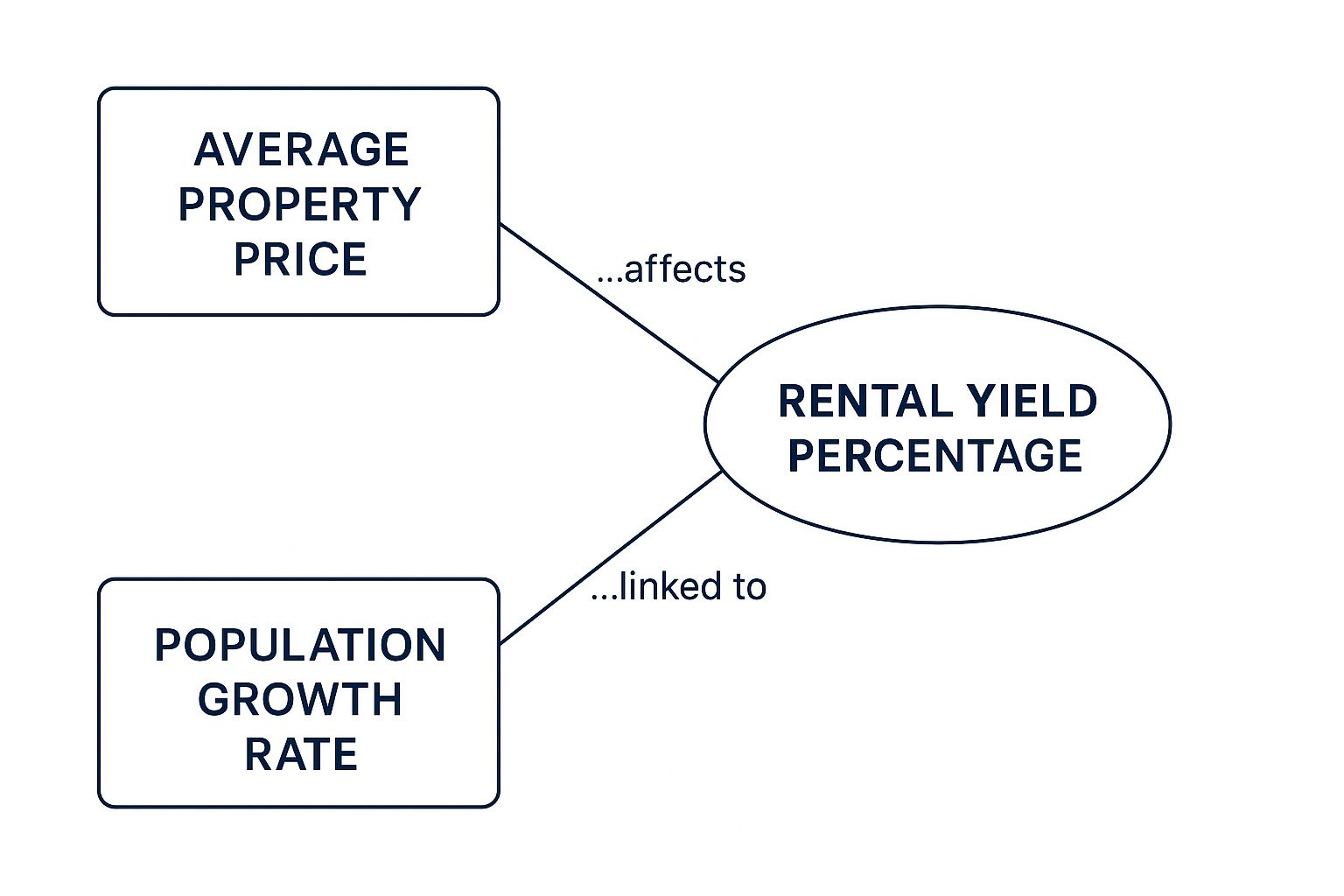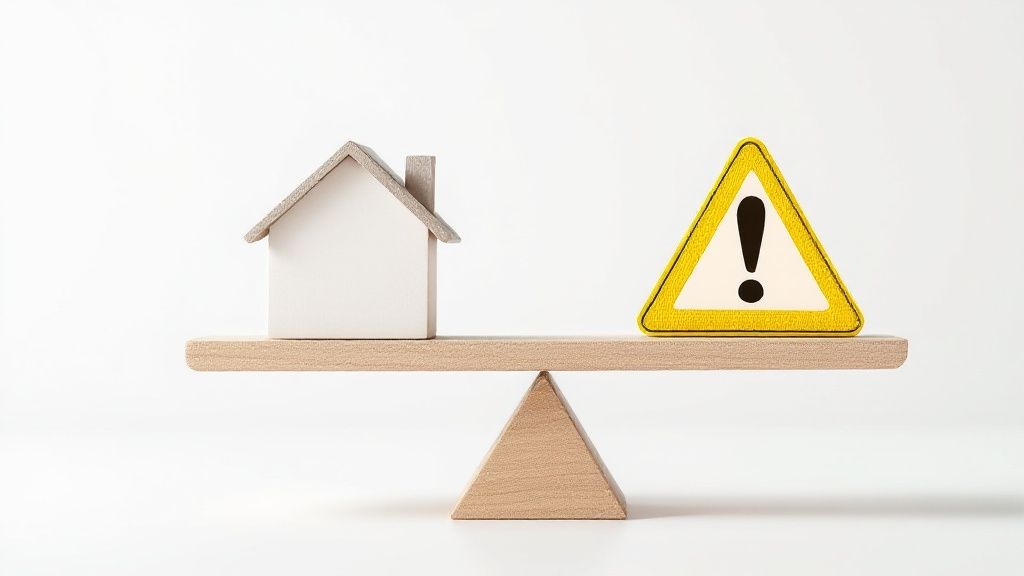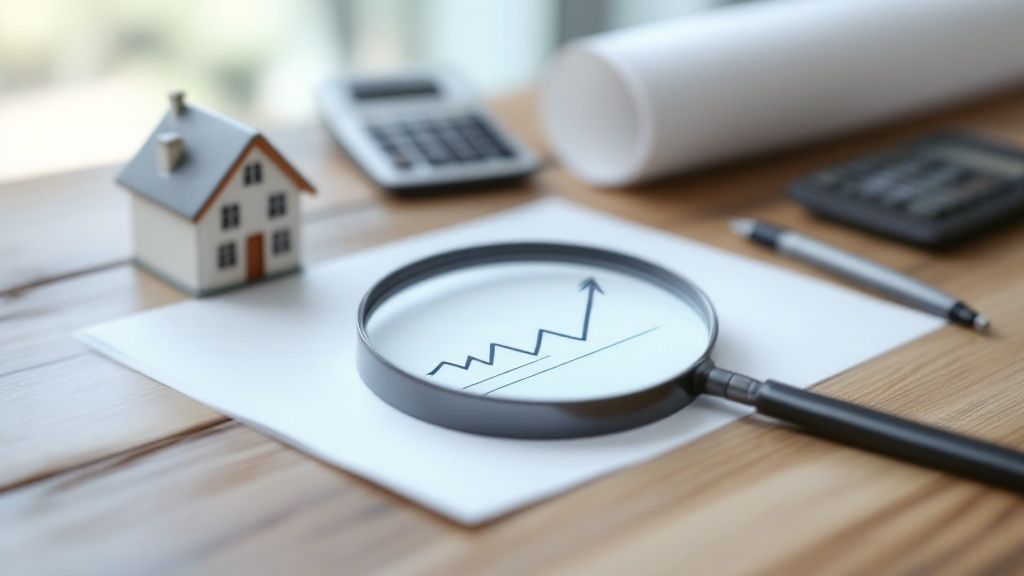What exactly is real estate investment analysis? It’s the essential process of looking past the curb appeal to determine if a property is a sound financial move. It’s a disciplined method of using financial data and market trends—not just a gut feeling—to forecast income, pinpoint a property's true value, and decide if it's worth your time and capital.
This isn't about guesswork; it's about making smart, data-driven decisions. This guide will give you the actionable insights and tools to do just that.
Why Real Estate Investment Analysis Is Your Financial Toolkit

Think of buying an investment property like building a house—you wouldn't start without blueprints and a full set of tools. Real estate investment analysis is that essential financial toolkit. It provides the instruments you need to measure, evaluate, and assemble a profitable investment.
Without these tools, you're essentially building blind, which is a surefire way to make costly mistakes.
A proper analysis forces you to move beyond superficial details, like fresh paint or a tenant's promise to pay on time. It makes you confront the numbers that truly determine whether a property will be a financial winner or a dud.
Moving from Guesswork to Strategy
The core purpose of running the numbers is to answer critical questions with data, not intuition. It’s how you transform a pile of raw information—like purchase price, rent rolls, and operating costs—into actionable intelligence that guides your every move.
This shift from hoping to strategizing is what separates amateur investors from seasoned professionals.
A solid analysis gives you a clear roadmap by helping you achieve several critical objectives:
- Forecast Potential Income: You can project exactly how much cash a property is likely to generate after all expenses are paid.
- Uncover Hidden Risks: It shines a light on potential problems, like underestimating maintenance costs or being too optimistic about local rental demand.
- Compare Properties Objectively: Analysis lets you stack up different opportunities side-by-side using the same metrics. No more comparing apples to oranges.
- Secure Financing with Confidence: Walking into a bank with a detailed financial breakdown of a deal is far more convincing than simply saying, "I have a good feeling about this one."
To help you get started, let's break down the core pillars of any solid property analysis. These are the non-negotiables you need to master for every potential deal.
Core Components of Real Estate Investment Analysis
| Component | What It Tells You | Actionable Insight |
|---|---|---|
| Market Analysis | The health and direction of the local real estate market. | Reveals demand, rent trends, and appreciation potential. A great property in a dying market is a bad investment. Use this to identify growth areas. |
| Income Analysis | The total potential revenue a property can generate. | This is the "top line" of your investment. It includes rent, fees, and other income sources. Verify this with current lease agreements. |
| Expense Analysis | All the costs associated with owning and operating the property. | Uncovers the true cost of ownership, from taxes and insurance to repairs and management fees. Always request at least two years of utility bills and tax statements. |
| Cash Flow Analysis | The net profit left over after all income is collected and all expenses are paid. | This is your bottom line—the actual money that ends up in your pocket. A property with negative cash flow is a liability, not an asset. |
| Return Metrics (ROI) | How much profit you're making relative to the amount of money you invested. | Metrics like Cap Rate and Cash-on-Cash Return allow you to objectively compare the profitability of different deals and decide where to deploy your capital. |
Understanding these five components is the foundation of a bulletproof investment strategy. They work together to give you a complete 360-degree view of an opportunity.
At its heart, real estate investment analysis is a framework for stress-testing an opportunity. It allows you to model different scenarios—what if interest rates rise, or a unit sits vacant for three months?—before your capital is ever at risk.
Ultimately, this entire process is about turning a spreadsheet of numbers into a clear "go" or "no-go" signal. Instead of feeling overwhelmed, you’ll see how each piece of the puzzle fits together. This foundational clarity gives you the confidence to invest wisely and build a resilient portfolio.
The Financial Metrics That Actually Matter
Once you have the big picture, a proper real estate investment analysis boils down to translating property data into a clear financial story. This is where the numbers do the talking. We're focusing on the core metrics that reveal a property's true profit potential.
These numbers act like a financial x-ray, letting you see past the curb appeal and diagnose the health of an investment. Without them, you're flying blind.
Calculating Net Operating Income (NOI)
The first and most fundamental metric you must master is Net Operating Income (NOI). Think of NOI as the property's pure, unfiltered profitability—before you even think about your mortgage or income taxes. It’s the truest measure of a building’s ability to generate cash on its own.
To find it, you take all the income the property generates (Gross Operating Income) and subtract all necessary operating expenses.
Here’s a practical breakdown:
- Income Sources: This is everything the property brings in. Monthly rent is the main component, but don't forget other revenue streams like parking fees, laundry machine income, or pet fees.
- Operating Expenses: These are the non-negotiable costs to keep the property running smoothly. This includes property taxes, insurance, maintenance, property management fees, and utilities.
Actionable Tip: NOI does not include your mortgage payments (debt service). This is intentional. It allows you to analyze the performance of the property itself, separate from how you choose to finance it, making it easier to compare different assets.
Using the Capitalization Rate (Cap Rate) for Quick Comparisons
With your NOI in hand, you can unlock the next powerful metric: the Capitalization Rate (Cap Rate). The Cap Rate is a vital tool for quickly sizing up a property's value and comparing it to other deals on the market. It shows you the potential rate of return on an investment property if you were to buy it with all cash.
The formula is simple: Cap Rate = NOI / Property Purchase Price.
Example in Action: A duplex has an NOI of $20,000 and is listed for $400,000. Its Cap Rate is 5% ($20,000 / $400,000). This single number lets you instantly benchmark it against other local duplexes. If similar properties are selling at a 4% Cap Rate, this one might be a good deal. If they're trading at 6%, you might be overpaying. You can get a much deeper look into these calculations with our guide to essential real estate math formulas.
The infographic below shows just how much market factors can influence the numbers you'll be running.

As you can see, things like population growth can support higher rents and property values, which directly flows back into the metrics you're using to make decisions.
Measuring Your Actual Return with Cash on Cash Return
While Cap Rate is fantastic for comparing deals, Cash on Cash Return tells you what really matters to your bank account: how hard your actual invested cash is working for you. This metric cuts through the noise and focuses on the return you get on the money you pull out of your own pocket.
It measures your annual pre-tax cash flow against the total cash you put into the deal.
Here’s a step-by-step guide to calculate it:
- Calculate Annual Cash Flow: Start with your NOI and then subtract your annual mortgage payments. This is the cash you're left with at the end of the year.
- Determine Total Cash Invested: Add up your down payment, all your closing costs, and any cash you spent on immediate repairs or improvements.
- Find the Return: Simply divide your Annual Cash Flow by your Total Cash Invested.
Example in Action: Let's stick with our duplex. If your annual cash flow comes out to $8,000 and you invested $100,000 of your own money to buy it, your Cash on Cash Return is 8%. It’s a powerful, personalized number that shows you exactly how your capital is performing.
How Professionals Value an Investment Property
Knowing how to value a property is the secret weapon in any serious investor's toolkit. It’s where the pros separate themselves from the amateurs, looking past the sticker price to see what a property is really worth.
Professionals don't just guess. They rely on three core methodologies to get a 360-degree view of a property's value. Using these ensures every decision is backed by solid numbers, not just gut feelings.
Each method gives you a different piece of the puzzle, and the right one often depends on the type of property you’re looking at.
The Sales Comparison Approach
This is the bread and butter of valuation, especially for single-family homes and small multi-family properties. The Sales Comparison Approach is exactly what it sounds like: you determine a property’s value by analyzing what similar, nearby properties have recently sold for. You’re essentially acting like your own appraiser.
The trick is finding good "comparables," or "comps." These are recently sold properties that mirror your target property in location, size, age, condition, and key features.
But no two properties are identical. That’s where adjustments come in.
- If a comp has a superior feature (like a brand-new kitchen your property lacks), you subtract value from its sale price.
- If a comp has an inferior feature (maybe it has one less bathroom), you add value to its sale price.
This process gives you a reliable estimate of the property's current market value—what a ready and willing buyer would likely pay for it today.
The Income Approach
When you’re looking at rental properties, the Income Approach is king. Period. This method values a property based on one thing: how much income it can generate. It's the ultimate investor's test because it ties the price directly to its cash-flow potential.
This approach is directly connected to the metrics we covered earlier, specifically Net Operating Income (NOI) and the Cap Rate. The formula is simple but incredibly powerful: Property Value = NOI / Cap Rate.
Example in Action:
Let’s say a small office building generates an NOI of $50,000 a year. If similar properties in that area are selling at a 6% Cap Rate, you can quickly estimate its value.
Example Calculation:
$50,000 (NOI) / 0.06 (Cap Rate) = $833,333 (Estimated Property Value)This tells you that, based purely on its income-generating power, the building is worth about $833,333 to an investor. This method cuts through emotion and gets straight to the financial performance.
For a deeper dive into the mechanics, you can explore the various real estate property valuation methods that pros use to nail down their numbers. It’s a fundamental part of any serious real estate investment analysis.
The Cost Approach
Finally, we have the Cost Approach. You won't use this one as often for typical flips or rentals, but it's essential for new construction or unique buildings that have few, if any, comps—think a school, a church, or a custom-built facility.
The logic is straightforward: a property shouldn’t be worth more than what it would cost to build a brand-new, equivalent one.
It’s a two-step process:
- Estimate the Replacement Cost: First, you calculate the total cost to build a similar property from the ground up today, including all materials and labor.
- Subtract Depreciation: Then, you account for how much value the existing property has lost over time due to wear and tear, age, or being outdated (what appraisers call "obsolescence").
The number you're left with is a value based on the property’s physical nuts and bolts. It's a logical approach, but its main job is to value those special-purpose properties where sales or income data just isn't available.
Choosing the right valuation method is a critical skill. The Sales Comparison Approach tells you what the market thinks a property is worth, but the Income Approach tells you what it's worth to you as an investor. Use them together, and you get a complete picture that lets you make confident offers and avoid overpaying for a deal.
Analyzing the Market for Long-Term Growth

Even the most profitable-looking property can become a financial anchor if it's in a declining market. A critical part of any real estate investment analysis is shifting your focus beyond the four walls of the building to the economic health of the surrounding city and neighborhood.
Think of it like this: your property is the boat, but the local market is the tide. A rising tide lifts all boats, pushing up your value and rental income. But a falling tide can leave even the best-kept boat stranded.
This big-picture view ensures your investment is built on a foundation of real, sustainable demand, not just wishful thinking. It's about making sure the external forces you can't control are working for you, not against you.
Spotting the Path of Progress
The most successful investors are masters at finding the "path of progress"—the direction a city is growing. Getting into an area just before it becomes the next hot spot is how generational wealth is built. To do this, you have to become a local economic detective, looking for clues that signal future growth.
These clues aren't secrets; they're public data points that tell a powerful story about where a market is headed. You’re looking for job trends, population shifts, and major local developments.
Look for these signs:
- Major Employer Announcements: Is a big tech company or hospital system opening a new campus? This creates a wave of high-paying jobs, which directly fuels housing demand.
- Infrastructure Projects: New light rail lines, highway expansions, or park developments make a neighborhood more accessible and desirable, driving up property values over time.
- Zoning Changes: Is the city up-zoning areas from single-family to multi-family? This shows they anticipate population growth and are planning for higher density.
Actionable Tip: Investing in the path of progress means you're not just buying a property; you're buying a piece of a neighborhood's future. You're positioning your asset to be lifted by the economic currents of growth and development.
Diving Deep into Due Diligence
Once you've found a promising macro-market, it's time to zoom in on the specific neighborhood. This hyperlocal due diligence is where you confirm the area has the right ingredients for a stable, long-term rental.
This means looking at more than just the property itself. The quality of the surrounding community directly impacts tenant demand, rental rates, and your property’s future appreciation.
For instance, strong global trends often trickle down to local confidence. Between the third quarter of 2024 and the second quarter of 2025, global real estate investment activity hit approximately US$3.4 billion. Transaction volumes in Q2 2025 alone reached US$179 billion, a 14% year-over-year increase. The Americas led with US$99 billion in Q2 2025, an 18% jump, signaling strong market fundamentals that often start with positive local trends. You can discover more global market insights from JLL to see how these larger trends take shape.
Key Factors for Location Analysis
A solid location analysis should feel like you’re preparing to move there yourself. You need to dig into the critical quality-of-life factors that attract and keep good tenants.
Your checklist should include:
- School District Quality: Even if you’re renting to tenants without kids, strong schools are a powerful magnet for families and a key driver of property values. GreatSchools.org is an invaluable resource for this.
- Crime Rates: Safety is non-negotiable for most tenants. Use local police department websites or online tools like NeighborhoodScout to get a clear picture of crime stats.
- Amenities and Walkability: Proximity to grocery stores, parks, restaurants, and public transit makes a location far more attractive. A high "Walk Score" is a great indicator of a convenient and desirable neighborhood.
- Local Ordinances and Zoning: Understand the local rules. Are there strict rental regulations or zoning laws that could limit what you can do with the property? A quick check of the city’s planning department website can save you massive headaches later.
By meticulously analyzing both the big-picture economic trends and the small-scale neighborhood details, you build a powerful case for your investment. This dual-focus approach is what separates a speculative gamble from a calculated, strategic investment poised for sustainable growth.
Your Ultimate Due Diligence Checklist
A sharp analysis is as much about dodging bad deals as it is about finding great ones. Once the initial numbers on a property look promising, it’s time to shift gears into due diligence—a systematic investigation to confirm all your assumptions and, more importantly, to uncover any hidden problems.
This isn’t just a formality; it's the critical process that stands between you and a costly mistake. Think of it as a comprehensive health check for your potential investment, moving you from the theoretical world of spreadsheets into the tangible reality of the property itself. Skipping this step is one of the biggest and most expensive blunders an investor can make.
We can break the entire process down into three core areas you absolutely must investigate.
Auditing the Financials
First things first: you have to stress-test your own analysis. Your goal here is to verify that the seller's numbers are legit and that your projections can handle a little turbulence. This is where you separate fact from fiction.
Your financial audit needs to include:
- Verifying Income: Get your hands on the current rent roll and copies of every single active lease. Do the numbers actually match what the seller advertised? Pay close attention to lease expiration dates to anticipate any upcoming vacancies.
- Scrutinizing Expenses: You'll want to request at least two years of utility bills, property tax statements, and insurance policies. These documents give you a real-world baseline for your expense projections, which are notoriously easy to underestimate.
- Stress-Testing Your Projections: Run a few "what-if" scenarios. What happens to your cash flow if interest rates jump by 1%? What if your vacancy rate hits 10% instead of the 5% you planned for? A truly strong deal should still hold up even when the assumptions get a bit worse.
Inspecting the Physical Property
A professional property inspection is completely non-negotiable. Sure, your initial walkthrough gives you a feel for the place, but a licensed inspector brings the tools and expertise to spot issues you’d never see—issues that could represent thousands in deferred maintenance and kill your returns.
Actionable Tip: A property inspector's job is to find problems. Your job is to decide if those problems are deal-breakers or just negotiation points. A $20,000 roof replacement might sink a deal, but a $500 plumbing fix is just part of the business.
Beyond that standard inspection, your physical due diligence should also dig into:
- The "Big Ticket" Items: Focus on the age and condition of the roof, HVAC system, foundation, electrical wiring, and plumbing. These are, by far, the most expensive systems to replace.
- Pest and Environmental Issues: Depending on where the property is located, you might need specialized inspections for things like termites, radon, or mold. Don't guess on this.
- Capital Expenditure Forecast: Start building a rough timeline and budget for future replacements. A water heater that’s already 12 years old is on borrowed time, and you have to account for that expense in your long-term financial plan.
For a more granular breakdown, our complete real estate due diligence checklist offers an in-depth guide to ensure you don't miss a single detail.
Clearing Legal and Title Hurdles
Finally, you have to ensure the property has a clean legal history and complies with all local regulations. Legal problems can become incredibly complex and expensive to sort out after you’ve taken ownership.
This part of your investigation confirms you're buying exactly what you think you are, free from any hidden claims or restrictions. This is where a title company becomes your best friend.
Your legal checklist must cover:
- Title Search: A title company will perform a detailed search to make sure there are no liens, unpaid taxes, or ownership disputes attached to the property. This is why title insurance is so essential—it protects you from claims that might pop up down the road.
- Zoning and Land Use: Call the local municipality to verify that the property's current use is legal. You also want to ask if there are any zoning changes planned for the area that could negatively impact your investment.
- Landlord-Tenant Laws: If you're buying a rental, you absolutely must understand the local and state laws governing evictions, security deposits, and tenant rights. Pleading ignorance of these rules won't hold up in court.
Putting It All Together: A Real-World Case Study

Theory and metrics are great, but the real test is seeing how they hold up on an actual deal. Let's walk through a complete analysis of a hypothetical duplex to see how these concepts translate into a clear go or no-go decision. Think of this as a practical blueprint you can apply to your own deals.
The property is a duplex with a $500,000 price tag. It's in a solid, middle-class neighborhood with good schools and growing rental demand. We're projecting that each unit can rent for $1,800 a month, giving us a potential gross annual income of $43,200.
Now, let's make the numbers talk.
Calculating the Key Financial Metrics
First things first, we need to figure out the property's Net Operating Income (NOI). This is the engine of its profitability. We'll start with our gross income and then subtract all the realistic operating expenses.
- Gross Potential Income: $43,200
- Vacancy (5%): -$2,160
- Property Taxes: -$6,000
- Insurance: -$1,500
- Maintenance (5%): -$2,160
- Property Management (8%): -$3,456
- Utilities (owner-paid): -$1,200
After all that, we’re left with a Net Operating Income (NOI) of $26,724. With this number, we can quickly calculate the Cap Rate to see if the price is in the right ballpark: $26,724 (NOI) / $500,000 (Price) = 5.35% Cap Rate. If similar duplexes nearby are selling at a 5% Cap Rate, this one seems reasonably priced.
Next up is the Cash on Cash Return. Let's assume a 20% down payment ($100,000) plus $10,000 in closing costs, making our total cash invested $110,000. The annual mortgage payment on the $400,000 loan (at 6% interest) comes out to $28,776.
Annual Cash Flow:
$26,724 (NOI) - $28,776 (Mortgage) = -$2,052That negative number is an immediate red flag. It tells us the property won't put a single dollar in our pocket. In fact, it'll cost us money every year just to own it.
Making the Final Investment Decision
Our analysis just revealed a huge problem: this property is cash-flow negative from day one. Even with a fair Cap Rate, the combination of high leverage and today's interest rates means the mortgage payments eat up all the profit and then some.
This is exactly where the power of analysis shines. It’s easy to get excited about a property's potential appreciation, but the numbers give a cold, hard verdict. As it stands, this deal just doesn’t work.
So, what are our options?
- Negotiate a Lower Price: We can take our analysis directly to the seller to justify a lower offer. The numbers don't lie.
- Increase the Down Payment: Putting more cash down would shrink the mortgage, which could push the cash flow into positive territory.
- Find a Way to Add Value: Is there room to add amenities or make improvements that would justify higher rents?
- Walk Away: Sometimes, the smartest move is to pass on the deal. There are always other properties with stronger fundamentals.
This case study proves that a systematic analysis is your best defense against a bad investment. It moves you from hoping a deal works out to knowing exactly what it takes to make it profitable.
Got Questions? We’ve Got Answers.
When you're digging into real estate analysis, a lot of questions pop up. It's totally normal, especially when you're just getting started. Here are some of the most common ones we hear, along with some straight-up, practical answers.
What Is a Good Cap Rate for an Investment Property?
This is the classic "it depends" question, but for good reason. A "good" Cap Rate is completely relative to the market, property type, and your own stomach for risk. There's no magic number.
In a hot urban market, for example, a property might sell at a 4-5% Cap Rate. That's not bad—it just reflects higher property values and the market's belief that it's a safer, more stable investment. On the flip side, you’d expect a much higher Cap Rate in a smaller, less predictable town—maybe 8-10% or more—to make the extra risk worthwhile.
Actionable Tip: Stop looking for a single "good" number and start using the Cap Rate as a benchmark. How does this property’s Cap Rate stack up against similar, recently sold properties right down the street? A 7% Cap Rate could be a steal in one city and a major red flag in another.
What Software Do Real Estate Investors Actually Use?
Plenty of old-school investors got their start building custom spreadsheets in Excel or Google Sheets, and that can work. But let’s be honest, it’s slow, and it's painfully easy for one tiny formula error to throw off your entire analysis.
Today, most serious investors lean on specialized software to speed things up and avoid those manual mistakes.
A few of the go-to platforms are:
- DealCheck: A really popular, user-friendly tool for analyzing everything from rentals and flips to commercial deals.
- BiggerPockets Calculators: A solid set of free and premium calculators backed by one of the biggest investor communities out there.
- TheAnalyst PRO: This one is a heavier-duty tool built for commercial real estate pros who need deep, detailed reports.
What’s the Single Biggest Mistake Investors Make in Their Analysis?
Hands down, the most common and costly mistake new investors make is underestimating expenses. It's so easy to get mesmerized by the potential rental income and gloss over the costs, but that’s a recipe for turning a great-looking deal into a money pit.
Newcomers almost always forget to budget for the big stuff—the new roof you’ll need in five years, the inevitable vacancies between tenants, and all the little maintenance calls that add up. A good rule of thumb to keep you honest is the 50% Rule. It suggests that, on average, your operating expenses (everything except the mortgage) will eat up about 50% of your gross rental income.
When in doubt, always be conservative and build a healthy cushion into your expense numbers.
Tired of spending hours buried in spreadsheets? Flip Smart gives you the power to perform a complete real estate investment analysis in seconds. Get accurate valuations, rehab cost estimates, and profit projections instantly, so you can make smarter, faster decisions. Analyze your next deal with Flip Smart.
